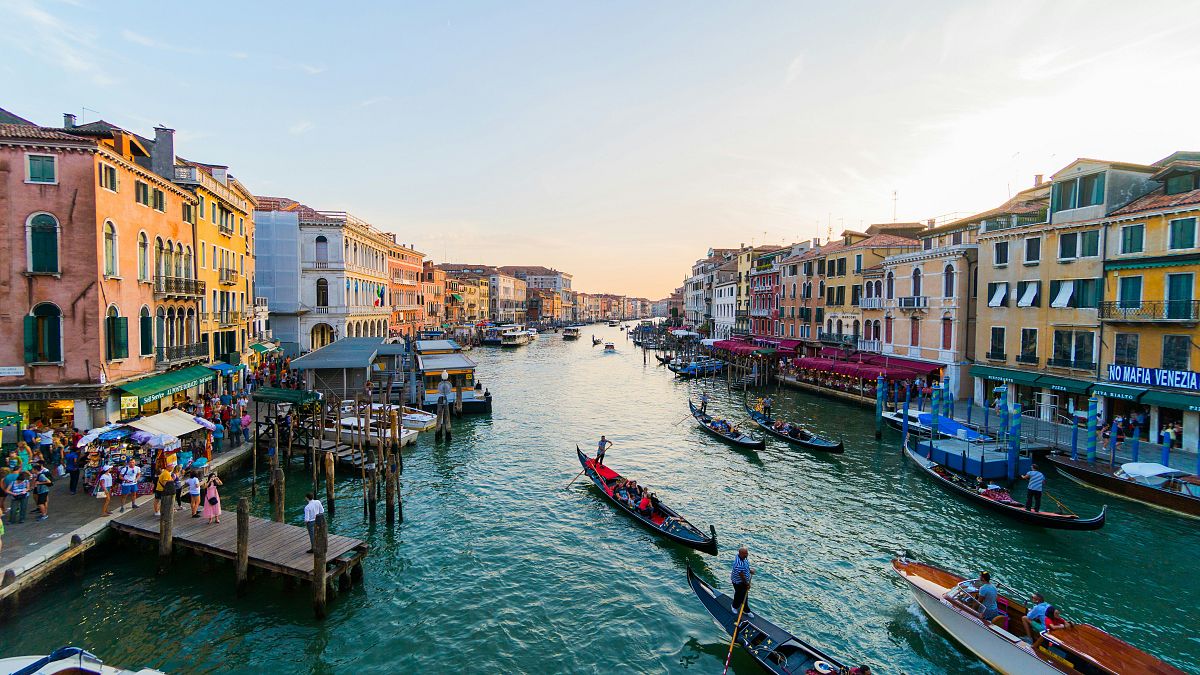The fee will go up to €10 for last minute bookings.
Venice will extend its day-tripper tax next year, increasing the number of days on which tourists have to pay to enter the city and doubling the fee to €10 for last-minute visitors, city officials said on Thursday.
Mayor Luigi Brugnaro stressed that the tax aims to help the city and its citizens battle overtourism and avoid huge influxes of visitors during crowded holidays and weekends.
The payment system was launched earlier this year for a time-limited pilot program.
Venice announced last year it would introduce the long-discussed day-tripper fee after the city narrowly escaped being placed on the UN’s list of endangered heritage sites, due largely to the impact of overtourism.
Visitors staying overnight in the historic centre are exempt from the charge as they already pay a tourist tax.
How does Venice’s entry fee work?
The new tax will be applied every Friday through Sunday and on holidays from 18 April to 27 July, for a total of 54 days.
That’s almost double the number of days it was applied this year. Tourists who don’t make reservations up to four days in advance will pay €10 instead of the usual €5.
The tax will be in force during peak hours, from 8.30 am to 4 pm
Exemptions are granted to residents, Venetian-born visitors, students and workers, as well as tourists who have hotel or other lodging reservations.
Anyone found beyond designated control points without the required documentation will be subject to fines.
These will range from €50 to €300, plus the maximum entrance fee allowed by law, set at €10.
Officials have emphasised that the programme aims to reduce crowds on peak days, encourage longer visits and improve the quality of life for residents.
The fee is not required for anyone staying in Venice, including the mainland districts of Marghera and Mestre. Venice’s islands, including glass-making Murano, are also outside the pilot program.
Exemptions are also issued for a variety of reasons, including to access the city for work, school or medical care, as well as to people born in Venice, and residents of the Veneto region.
Why has Venice introduced an entry fee?
Venice has long suffered under the pressure of overtourism, but officials say pre-pandemic estimates ranging from 25 to 30 million visitors a year – including day-trippers – are not reliable and that the pilot project also aimed to come up with more exact figures to help better manage the phenomenon.
By contrast, registered visitors spending the night last year numbered 4.6 million, according to city figures, down 16 per cent from pre-pandemic highs.
The pandemic delayed Venice’s plans to launch the day-tripper tax, which has become a keystone of the city’s attempts to deal with overtourism.
UNESCO cited the plan when it decided not to include the city on the list of endangered world heritage sites last September, a tarnish that it similarly avoided two years earlier with the cruise ship ban through St. Mark’s Basin and the Giudecca Canal.
Cruise ships brought 1.6 million people to Venice in 2019.
Activists sounded a warning last summer when the number of tourist beds officially overtook the number of residents, which has dwindled to under 50,000 in a trend dating back decades.
They said the imbalance drains the city of services, clogging its tight alleyways and water buses with suitcase-toting tourists and pushing residents to the mainland with its conveniences.
Was the trial of the entry fee a success?
At the end of the first test phase in July, officials said the tax had netted €2.4 million, accounting for about 1,000 entrances on each of the test days.
Brugnaro on Thursday again responded to critics who have called it a failure and said it did not deter as many arrivals as expected.
“Venice is the first city in the world that tries to manage the problem of overtourism. We obtained important results,” the mayor said.
But some citizens’ groups and opposition councillors claim the access fee completely failed to control overtourism.
“Data offered by the control room show that on average during the period of implementation of the fee, we had about 7,000 more tourist entries than in previous years,” said Giovanni Andrea Martini, an opposition councillor.
“This shows that the access fee is not at all a system able to manage the flows.”
Read the full article here
